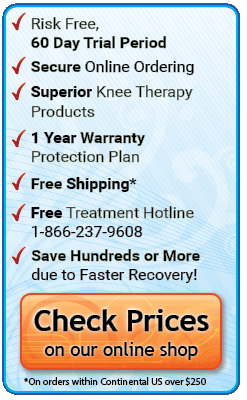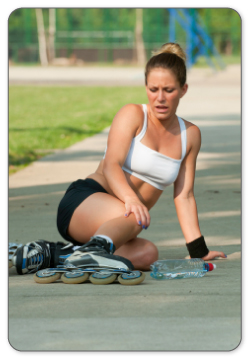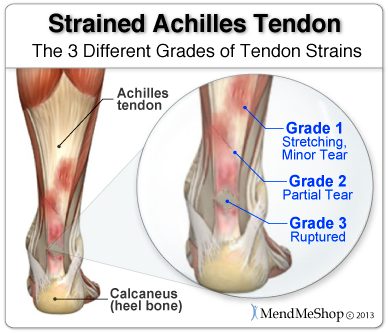What is a sprain?
A sprain is a stretch and/or tear of a ligament (fibrous band of connective tissue that joins bone to bone). Every joint in the body is stabilized and supported by a ligament. They help control range of motion and enabling us to complete simple tasks such as walk and run.
What is a strain?
A strain is stretching and/or micro-tearing of a muscle and/or tendon. (unlike a ligament, a tendon joins muscle to bone)
Sprains and strains are among the most common injuries in sports, professional, amateur athletes and the general public. You are more at risk for the injury if you have a history of sprains and strains, are overweight, and are in poor physical condition.
Tendons are fibrous cords of tissue that attach muscles to bone.
Ligaments are tough fibrous cords of tissue that attach bone to bone.
Sprains And Strains Are Categorized According To Severity:
- MILD - A tendon is stretched in a mild sprain, but there is no joint loosening.
- MODERATE - A moderate sprain partially tears the tendon, producing joint instability, and some swelling.
- SEVERE - A severe sprain produces excruciating pain at the moment of injury, as muscle tear completely, or separate from the bone. The complete rutupre makes the joint nonfunctional.

You should seek medical attention if you can't walk more than four steps without pain, can't move the affected joint and you have numbness in any part of the injured area.
SPRAIN
What are the Signs of a Sprain?
While the intensity varies, pain, bruising, swelling, limited ability to move the affected joint, and inflammation are common to all three categories of sprains: mild, moderate, and severe. You may feel a tearing or hear a 'pop' sound in the joint.
What causes sprains?
A sprain is caused by direct or indirect trauma (a fall, a blow to the body, etc.) that knocks a joint out of position, and overstretches, and, in severe cases, ruptures the supporting ligaments. This injury occurs when an a person lands on an outstretched arm; slides into a base; jumps up and lands on the side of the foot; or runs on an uneven surface.
The most common types of sprain are as follows:
- Ankle sprain. The foot twists, rolls or turns beyond its normal motions. You can sprain your ankle if the foot is planted unevenly on a surface, beyond the normal force of stepping. Approximately 25,000 people each day suffer the pain of an ankle sprain. (source American Academy of Orthopaedic Surgeon) The foot and ankle is made up primary of ligaments holding the bones together. There are 7 ankle related sprains; high ankle, lateral, inversion, eversion, syndesmosis, anterior talofibular ligament, and anterior inferior tibiofibular ligament sprains! Sports related to high risk ankle sprains, are one that require sudden changes in direction, like football, soccer, and basketball.
- Knee sprain. There are 4 major ligaments in the knee:
- Anterior cruciate ligament (ACL) and posterior cruciate ligament (PCL) bridge the inside of the knee joint, forming an "X" pattern that stabilizes the knee against front-to-back and back-to-front forces. A sudden stop; a twist, pivot or change in direction at the joint; extreme overstraightening (hyperextension); or a direct impact to the outside of the knee or lower leg. Knee sprain injuries are seen among athletes in football, basketball, soccer, rugby, wrestling, gymnastics and skiing. Read more about Anterior Cruciate Ligament (ACL) or Posterior Cruciate Ligament (PCL) injuries.
- Medial collateral ligament (MCL) supports the knee along the inner side of the leg. Like the ACL, the MCL can be torn by a direct sideways blow to the outside of the knee or lower leg, the kind of blow that can happen in football, soccer, hockey and rugby. The MCL can be injured by a severe knee twist during skiing or wrestling, particularly when a fall twists the lower leg outwards, away from the upper leg. Read more about Medial Collateral Ligament (MCL) injury.
- Lateral collateral ligament (LCL) supports the outer side of the knee. It is the least likely knee ligament to be sprained because most LCL injuries are caused by a blow to the inside of the knee, and that area usually is shielded by the opposite leg. Read more about Lateral Collateral Ligament (LCL) injury.
More than any other group, competitive athletes have a very high risk of knee sprains and other types of knee problems.
- Wrist sprain. A fall onto an outstretched hand, the force impact bends the wrist back toward your forearm, stretching and ligaments that connect the wrist and hand bones a little to far. A momentary loss happens during everyday activities, but frequently occurs during sports and outdoor recreation. Wrist sprains are common with basketball, baseball, gymnasts, divers, skiers (especially when they fall while still holding a pole), skaters, skateboarders, and inline skaters
- Finger sprain. Injury to three joints of the fingers 'jamming' the finger into an opponent or being hit on the tip of the finger by a ball. Bending the finger backward (hyperextended). Are often overlooked as 'just a finger', finger injuries can be very painful and lead to chronic ailments (trigger finger) if not treated correctly.
- Toe sprain. Stubbing your toe into something, stopping suddenly when running or landing awkwardly from a jump 'jamming' your toe into your shoe. Sports such as football, soccer, rugby, basketball and running.
STRAIN
What are the Signs of a Strain?
Signs include pain, muscle spasm, muscle weakness, swelling, inflammation, limited ability to move the affected muscle, and cramping. With a mild strain, the muscle/tendon is stretched or pulled, slightly. Some muscle/tendon function will be lost with a moderate strain, where the muscle/tendon is overstretched and slightly torn. In severe strains, the muscle and/or tendon is partially or completely ruptured, often disabling the person.
The most common types of strains are as follows:
- Achilles tendon strain. Pain along the back of your foot and above your heel, especially when stretching your ankle or standing on your toes. Most strains are mild. The seriousness of the strain will affect your walking. Suddenly increase your activity or warm up improperly can cause an Achilles tendon strain. Trying to go fast, jumping (hurdles), cutting (football) or twisting in the air are just some of the scenarios where you could develop Achilles tendon strain.
- Back strain. When the muscles that support the spine are twisted, pulled, or torn, the result is a back strain. Athletes who engage in a lot jumping (during basketball, volleyball, etc.) are at risk to this injury. Everyday activities can lead to back strain, pickup a heavy item and twisting at the same time as in loading groceries into the car, carrying laundry up stair and turning too quickly.
- Hamstring muscle strain. A hamstring muscle strain is a tear or stretch of a major muscle in the back of the thigh. The injury can sideline a person for up to six months. The likely cause is muscle strength imbalance between the hamstrings and the muscles in the front of the thigh, the quadriceps. Kicking a football, running, or leaping to make a basket can pull a hamstring. Hamstring injuries tend to recur.
- Quadricep strain. Muscle strain in the front thigh (quadriceps muscles in the front, and the adductor muscles on the inside.). The hamstring and quadriceps muscle groups are particularly at risk for muscle strains because they cross both the hip and knee joints. They are also used for high-speed activities, such as track and field events (running, hurdles, long jump), football, basketball, and soccer.
- Calf strain. Stretches, tears, or incomplete ruptures of the large calf muscles (gastrocnemius). Also called 'Tennis leg' happens when lunging or pushing off one leg to get to a wide ball or serve. May also happen with daily activities, such as running to catch a bus or climbing stairs. It feels like being kicked in the leg from behind. The tennis leg sufferer feels an quick severe sharp pain, turns around to see who kicked them, only to discover that no one is there.
- Elbow strain. A strain is when a muscle becomes overstretched and tears. This painful injury, also called a "pulled muscle," can be caused by an accident, improper use of a muscle, or overuse of a muscle. Frequently occur in racquet, throwing, and contact sports.
- Shoulder strain. Your shoulders (deltoid muscles) are the most movable joints in your body. Overuse, repetitive motion or an unnatural twisting of the shoulder are causes of shoulder strain. Quite often the due to swelling, which can make almost any movement in the cavity of the shoulder joint both difficult and uncomfortable.
- Hand strain. Repetitive strain injuries are linked with work related usage of the hands. A tight grip or squeezing the hand overstretches the hand muscles. Women are at high risk as 'standard' hand tools are often too large, too wide or too slippery. Sports such as gymnastics, tennis, rowing, golf-sports that require extensive gripping-have a high rate of injury.
- Neck strain. Not considered a serious injury, but there is pain and dysfunction of the neck. The causes are too much time in an awkward position (hunched over a steering wheel while driving, hunched forward to view a computer monitor, or cradling a phone in the crook of the neck). Sleeping in a position that strains the neck, such as with a pillow that is too high or too firm. Carrying a heavy suitcase or other object on one side of the body.

Treatment for Sprains and Strains
For years, doctors, trainers, and other medical professionals have recommended RICE (Rest, Ice, Compression, Elevation) to treat the pain and swelling of fresh injuries, chronic pain, and after any re-injury. Mild and moderate cases of tendon or muscle strain are best treated with conservative home therapies. Severe injuries may require surgery so consult your doctor for suggested treatment.
Using an Ice Pack (or something cold like a bag of peas) cools the injury area. It works by stopping and slowing nerve and tissue function in the injured area and reducing swelling that can block blood vessels.
Resting the injured knee (meaning don't use it at all!) helps prevent the injury from worsening. Not resting a soft tissue injury is dangerous, as this will increase the risk of re-injury and increased swelling - eventually this will become chronic. The quickest (and safest) way to repair damaged soft tissue at home is to rest and incorporate the use of TShellz Knee Wraps at least twice per day .
The growth of scar tissue and adhesions are a big problem when recovering from a knee injury. Scar tissue/adhesions are what cause stiffening in the tendons and muscle, entrapping nerves, restricting movements, and reducing blood flow.

Unfortunately, scar tissue does not "just go away". Depending on your activity level, age, and therapy done during your rehabilitation, it may never go away. Scar tissue is a major problem as it will permanently reduce flexibility and vastly increase your risk of re-injury. When dealing with scar tissue it is always important to:
- listen well to your physician. If conservative treatments are recommended, remember to stick to your (daily) treatment plan using these therapies
- frequent use of an ice pack will help reduce the swelling very quickly. Much of the pain you feel will be from the swelling, and you will be surprised how fast the pain drops off once the swelling is down.
- TShellz Wrap® is a safe, medical device that is, in our view the most effective home conservative treatment tool to help reduce scar tissue and increase blood flow to soft tissue in the knee (thereby accelerating the body's own healing process).
- when applied before stretching, the TShellz Wrap® will help flush the area with fresh blood. This will help improve your range of motion and prevent re-injury.
Circulation Boost via the Knee TShellz Wrap®
Once the inflammation in your leg has been reduced, providing extra blood flow and strengthening the tissue in the muscles, tendons, and surrounding area is recommended.
The intent of Circulatory Boost is to speed your recovery and heal your injury more completely preparing it for strengthening exercises. Circulatory Boost increases the amount of blood that flows naturally to your soft tissue to nourish your tendons, ligaments and muscles, improving elasticity and accelerate the bodys own ability to heal itself.. This increased Circulation Boost to your tendon or muscles is greatly needed.
Using the TShellz Wrap® is truly a unique experience. Within moments of applying a TShellz Wrap® to your knee, you can feel the healing sensation due to the increase in blood flow deep within the area. During a treatment, and for quite some time after you finish, your injured knee tendons, ligaments, bursa and muscles will feel gently warmed and more relaxed. It's a very soothing sensation and extremely effective.

Continue the healing process by resting your injury. Limit your movements that may aggravate your strain and lead to reinjury. Tendon / Muscle related injuries can easily turn from a grade 1 strain into a grade 2 or a grade 2 into a grade 3 injury.
No one is immune to Sprains or Strains but Using
T•Shellz will help Reduce Your Risk of Re-Injury while
Increasing Blood Flow to Soft Tissue in Your Knee
Giving yourself a T•Shellz Treatment will helps increase elasticity of soft tissue (via warming) and stimulate your blood circulation in the treatment area. As such, the use of a TShellz Wrap® is recommended before exercise or strenuous activity as it will help prevent further strain or reinjury due to increased tissue flexibility.
It may seem hard to believe, but our TShellz Wrap® will assist you in recovering from your injury faster and reduce the chance of degenerative conditions by maximizing blood flow where it is needed most, while reducing swelling and inflammation induced pain.
If you want to prevent further damage to your knee injury, accelerate your bodys healing process, reduce swelling and increase circulation for lifelong health benefits, proper use of an ice pack and a Knee TShellz Wrap® will provide exceptional results. Why spend time in pain, off from work, and missing out on your active lifestyle when you can be proactive about your injury and the health of your body? Talk to your doctor about incorporating the use of a Knee TShellz Wrap® in your everyday health regimen.

Our customer service lines are open 5 days a week helping people understand their injuries and how to treat them. Simply call toll free 1-866-237-9608 to talk with one of our knowledgeable Product Advisors. They have the ability to answer questions and even put together a treatment plan for you.
Product Advisors are available 9:00 am to 5:00 pm Eastern Standard Time Monday to Friday.
Learn More About SUPERIOR Knee Treatments
Learn more about Knee Surgery and Post-Surgery Recovery
Learn more about how the TShellz Wrap® stimulates blood flow.
Learn more about Ice vs Heat Treatments for Knee Strain
FREE SHIPPING ON ALL PRODUCTS CURRENTLY ENABLED
60 DAY TRIAL PERIOD
During your recovery, you will probably have to modify and/or eliminate any activities that cause pain or discomfort at the location of your soft tissue injury until the pain and inflammation settle. The more diligent you are with your treatment and rehabilitation, the faster you will see successful results!

